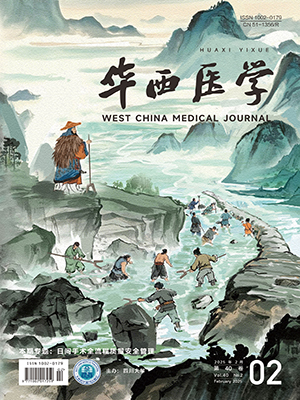| 1. |
文细毛, 任南, 吴安华, 等. 全国医院感染监控网细菌耐药情况及变化趋势[J]. 中国感染控制杂志, 2009, 8(6):389-396, 408.
|
| 2. |
刘华, 罗蓓蓓. ICU医院感染多重耐药菌类型、耐药性及感染相关因素研究[J]. 实用医院临床杂志, 2009, 6(3):140-142.
|
| 3. |
李文郎, 唐恒锋, 王文杰, 等. 神经外科ICU与普通神经外科医院感染病原菌及耐药性对比研究[J]. 中国医药导刊, 2011, 13(11):1957-1958, 1939.
|
| 4. |
李倩, 武元星, 唐明忠, 等. 神经外科重症监护病房细菌流行及耐药性的20年监测[J]. 临床神经外科杂, 2016, 13(1):49-59.
|
| 5. |
朱爱萍, 朱彦, 王新民, 等. 多重耐药菌感染监测与预防控制措施[J]. 医药论坛杂志, 2010, 31(20):175-176.
|
| 6. |
王宏沛, 孟灵, 王鸿玮, 等. 多重耐药菌监测与易感因素的临床研究[J]. 兰州大学学报:医学版, 2005, 31(2):55-56.
|
| 7. |
孙晓, 张平, 华卫红, 等. 多重耐药菌医院感染相关因素与控制[J]. 现代医药卫生, 2009, 25(16):2535-2536.
|
| 8. |
中华人民共和国卫生部. WS/T 312-2009医院感染监测规范[S]. 2009.
|
| 9. |
中华人民共和国卫生部. 关于印发医院感染诊断标准(试行) 的通知[EB/OL]. (2001-11-07)[2014-01-01]. http://www.nhfpc.gov.cn/yzygj/s3593/200804/e19e4448378643a09913ccf2a055c79d.shtml.
|
| 10. |
中华人民共和国卫生和计划生育委员会. 医院感染管理质量控制指标(2015年版)[EB/OL]. (2015-04-10)[2015-05-01]. http://www.nhfpc.gov.cn/ewebeditor/uploadfile/2015/04/20150415094217171.pdf.
|
| 11. |
Richet H. Seasonality in gram-negative and healthcare-associated infections[J]. Clin Microbiol Infect, 2012, 18(10):934-940.
|
| 12. |
Chazan B, Colodner R, Edelstein H, et al. Seasonal variation in Escherichia coli bloodstream infections in northern Israel[J]. Clin Microbiol Infect, 2011, 17(6):851-854.
|
| 13. |
Ramos GP, Rocha JL, Tuon FF. Seasonal humidity may influence Pseudomonas aeruginosa hospital-acquired infection rates[J]. Int J Infect Dis, 2013, 17(9):e757-e761.
|
| 14. |
王枢群, 张邦燮. 医院感染学[M]. 重庆:科学技术文献出版社重庆分社, 1990:50-83.
|
| 15. |
Perencevich EN, Mcgregor JC, Shardell M, et al. Summer peaks in the incidences of Gram-negative bacterial infection among hospitalized patients[J]. Infect Control Hosp Epidemiol, 2008, 29(12):1124-1131.
|
| 16. |
McDonald LC, Banerjee SN, Jarvis WR. Seasonal variation of Acinetobacter infections:1987-1996. Nosocomial infections surveillance system[J]. Clin Infect Dis, 1999, 29(5):1133-1137.
|
| 17. |
蒋国钦. ICU病人鲍曼不动杆菌定植的流行病学特征及危险因素探讨[D]. 苏州:苏州大学, 2011.
|
| 18. |
Fournier PE, Richet H. The epidemiology and control of Acinetobacter baumannii in health care facilities[J]. Clin Infect Dis, 2006, 42(5):692-699.
|
| 19. |
Climo MW, Yokoe DS, Warren DK, et al. Effect of daily chlorhexidine bathing on hospital-acquired infection[J]. N Engl J Med, 2013, 368(6):533-542.
|
| 20. |
Dixon JM, Carver RL. Daily chlorohexidine gluconate bathing with impregnated cloths results in statistically significant reduction in central line-associated bloodstream infections[J]. Am J Infect Control, 2010, 38(10):817-821.
|




